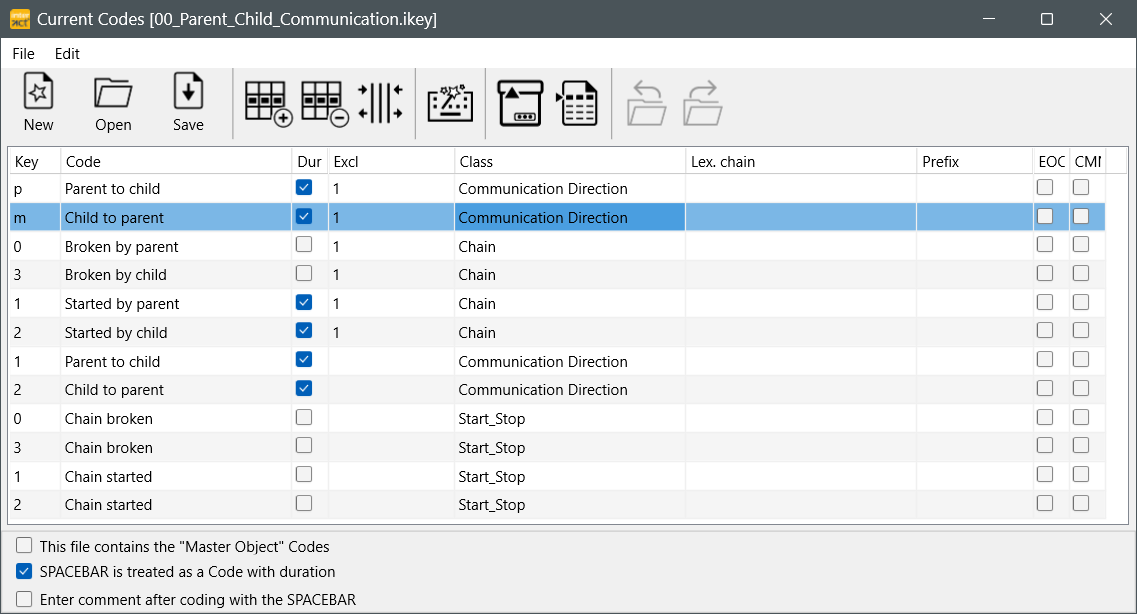Example: Presume you are observing two subjects and are interested in their communication skills.
You are especially interested in them building 'chains of communication', this means you want to log who starts the communication and who breaks it.
You also want to keep track of the in between communication as such.
Important is, that you use separate Codes to log the start and the end of each chain.
Code Definitions
To log Events for the presumed situation, you can use Code definitions like shown in the picture:

Note: Several Codes are assigned to the same shortcut [key]. This is NO mistake!
It is in fact a little trick, that allows us to simultaneously enter several Codes with a single key stroke or click. This enables us different 'views' on the data during the statistics, without having to alter the data manually after it has been logged.
Code Setup Explanation
There are the following possible situations:
oOne of the participants (tries to) start(s) a communication
oAn existing communication is proceeded
oAn existing communication is broken
For every attempt to start a communication, the keys [1] and [2] are used to log the direction of the communication.
As soon as a communication is taking place, the direction of the communication is logged with the Codes assigned to the keys [m] and [c].
To break a communication, the keys [0] and [3] are used, depending on who broke it.
This could result in range of Events coded with [1], [1], [m], [p], [m], [p], [3], if the parent tried to start the communication twice before the child communicated back, than there were two more turns between parent and child before the child broke the communication.
Pressing one of the [numbers] does not only enter the 'Communication Direction', but additionally enters the required information into the Classes 'Chain' and 'Start_Stop'.
The additional entries into the Class 'Communication Direction' enables us to get the duration and frequencies for communications 'Parent to child' and 'Child to parent', independent from the fact if they started a chain or not.
The additional Codes, automatically entered, in the Class 'Chain' when one of the [numbers] is pressed, allow us to count how often the parent starts and/or breaks the chain and the same for the child.
Last but not least, pressing one of the [numbers] will enter an extra Code into the Class 'Start_Stop'. Those Codes are used to identify the start and the end of each chain of communication.
We cannot use the Codes from the Class 'Chain' for that, because we'll never know who will break the chain after it has started...
Log Events
Using the Codes as defined, this is what happens during logging Events:
▪Make sure the correct Code definitions are loaded
▪Create a new INTERACT document by choosing File – New from the main menu.
Or, if you want to log the data in an existing document:
▪Open this document and choose Edit – Add Classes to active Document from the Code definition menu, to insert the missing Classes.
▪Open the Control panel options and select the coding mode 'Standard', in addition I advise to also select the option ‘Push & release mode’ in this case.
▪Make sure the video is loaded
▪Start the Observation Modus by clicking ![]() .
.
▪Press e.g. [1] if the parent starts the communication and hold it down for as long as the parental communication lasts.
An Event containing the Codes assigned to [1] and the exact start time appears in your document.
▪Release the [1] if the parental communication stops.
The end time for this Event is logged.
▪Press the [c] as soon as the child starts communicating back,
(this could bebefore the parental communication ends!)
An Event containing the Codes assigned to [c] and the exact start time appears in your document and so on...
▪Press [m] if the parent does not break the chain, etc.
▪As soon as the chain is broken, press the key indicating by whom it was broken.
Note: There can be multiple succeeding 'Chain started' Events, because every attempt to start a conversation is rated that way, independent of the fact if the communication was continued. Each “chain broken…” code should be followed by a “Chain started….” Code, but INTERACT cannot control this.
In this case we presume that each attempt to start a communication after the chain was broken, will be logged as a 'chain started', although it could never lead to a real 'chain', but we never know that up front. With the help of the Contingency Analysis we can extract the 'real' communication chains.